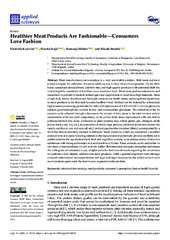Приказ основних података о документу
Healthier Meat Products Are Fashionable—Consumers Love Fashion
| dc.creator | Kurćubić, Vladimir | |
| dc.creator | Stajić, Slaviša | |
| dc.creator | Miletić, Nemanja | |
| dc.creator | Stanišić, Nikola | |
| dc.date.accessioned | 2022-10-27T11:29:57Z | |
| dc.date.available | 2022-10-27T11:29:57Z | |
| dc.date.issued | 2022 | |
| dc.identifier.issn | 2076-3417 | |
| dc.identifier.uri | https://www.mdpi.com/2076-3417/12/19/10129 | |
| dc.identifier.uri | http://aspace.agrif.bg.ac.rs/handle/123456789/6199 | |
| dc.description.abstract | Meat manufacturers are nowadays in a very unenviable position. Both meat and meat products require the utilization of various additives due to their chemical composition. On the other hand, consumers demand fresh, additive-free, and high-quality products with extended shelf-life, which might be considered as healthier, even functional food. These facts push manufacturers and researchers in pursuit of modern technologies and supplements to meet these high demands. Since a high daily intake of sodium and fat might cause severe health issues, reducing these ingredients in meat products is the first task towards healthier food. Sodium can be reduced by ultrasound, high-pressure processing, pulsed electric field, and replacement of NaCl with KCl, calcium gluconate, calcium glycerophosphate, calcium lactate, and monosodium glutamate. The reduction of the fat content can be achieved through a decrease in the amount of fatty tissue in the inital mixture and/or replacement with non-lipid components, or by partial fatty tissue replacement with oils rich in polyunsaturated fatty acids. Utilization of plant proteins (soy, wheat gluten, pea, chickpea, lentil, potato, barley, oat, rice, etc.), mycoproteins or micro-algae proteins, plant fats (palm and coconut fat, canola, sunflower, soy and corn oil, etc.), and polysaccharides (starches, fibers), accompanied by a meat-like fibrous structure, resulted in delicious “meat” products, which are considered a healthier alternative to real meat. Growing interest in the replacement of potentially adverse synthetic meat additives favors the use of plant (herb, fruit and vegetable) extracts, as an endless source of bioactive substances with strong antioxidant and antimicrobial activities. These extracts can be used either in raw meat or meat products, as well as in the fodder. Reformulation strategies strengthen and ensure the willingness of consumers to pay a higher price for their own demands regarding the naturalness of synthetic, clean-labeled, additive-free meat products. After a gradual alignment with strategic national/international recommendations and legal/sub-legal frameworks, the added value of such meat products opens wide the door to new segments/entire markets. | |
| dc.language | en | |
| dc.relation | info:eu-repo/grantAgreement/MESTD/inst-2020/200088/RS// | |
| dc.rights | openAccess | |
| dc.rights.uri | https://creativecommons.org/licenses/by/4.0/ | |
| dc.source | Applied Sciences | |
| dc.source | Applied Sciences | |
| dc.subject | consumer’s perception | |
| dc.subject | human health hazards | |
| dc.subject | meat products | |
| dc.subject | reformulation strategy | |
| dc.title | Healthier Meat Products Are Fashionable—Consumers Love Fashion | |
| dc.type | article | en |
| dc.rights.license | BY | |
| dc.citation.issue | 19 | |
| dc.citation.rank | M22 | |
| dc.citation.spage | 10129 | |
| dc.citation.volume | 12 | |
| dc.identifier.doi | 10.3390/app121910129 | |
| dc.identifier.fulltext | http://aspace.agrif.bg.ac.rs/bitstream/id/24112/Healthier_Meat_Products_pub_2022.pdf | |
| dc.type.version | publishedVersion |


